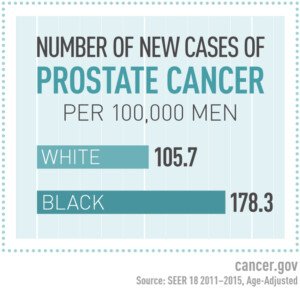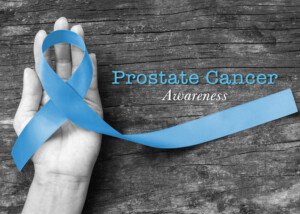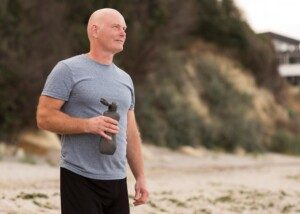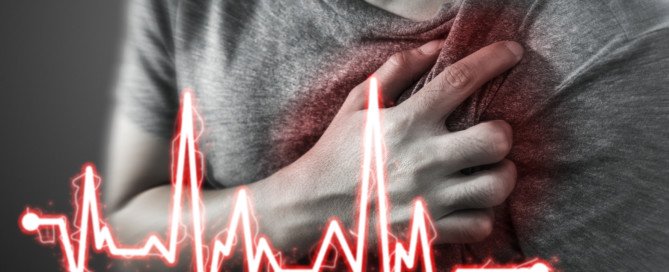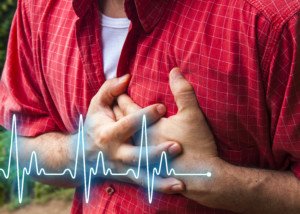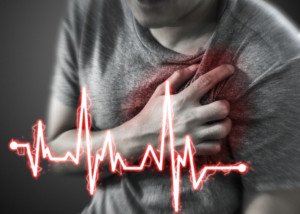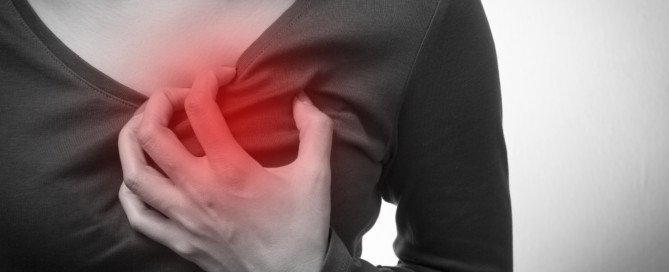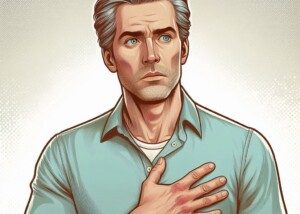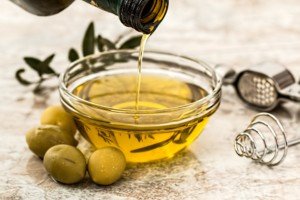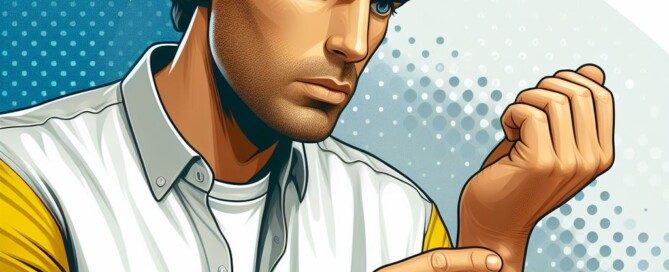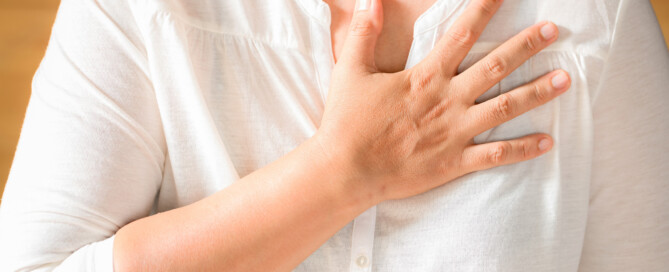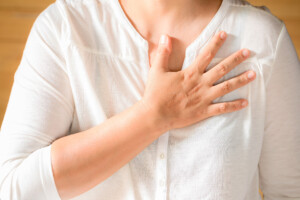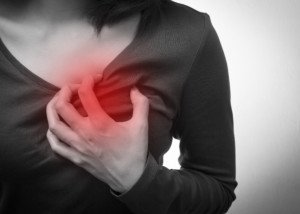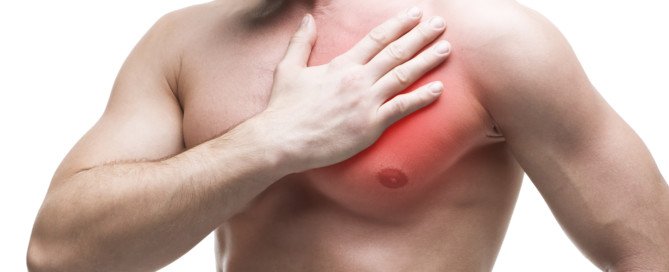How a Heart Attack Occurs without Blocked Arteries
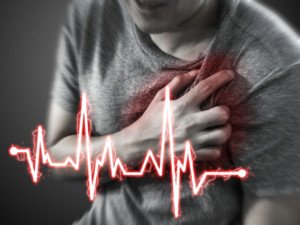
Explanation for how a heart attack can happen with or without a blockage:
Why blockages of only 30-50% are a higher risk for a catastrophic cardiac event than severely blocked arteries are.
It’s hard to believe, but it’s true: A big heart attack is more likely to occur when a person has a 30-50% blockage in their coronary arteries than if they are over 70 percent blocked.
But this phenomenon refers to a particular cause of the heart attack.
“A heart attack is when heart muscle cells die,” says Alvaro Waissbluth, MD, an Ohio-based heart surgeon who’s board certified in interventional cardiology and cardiovascular diseases, and founder of Eat Tank, an educational nutrition initiative that provides simple tools and practical knowledge for better understanding food.
He continues, “Heart muscle cells die when they don’t get enough oxygen or nutrients or if they get attacked by something and destroyed.” There are basically three kinds of heart attacks.
Heart attacks can happen with or without a blockage.
A plaque rupture in the coronary artery can cause a complete “mechanical interruption in the flow of oxygen and nutrients to the [cardiac] muscle,” says Dr. Waissbluth.
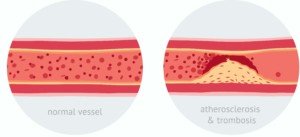
Shutterstock/eranicle
Plaque buildup (the “clog” in arteries) results from numerous insults including smoking, lack of exercise, high sugar intake, diabetes and, to some extent, genetics.
Imagine the sludge of plaque gradually building up over time, decreasing the inner diameter of the artery, eventually to a pinpoint diameter—where only a hair-width stream of blood could get through.
And then eventually, the buildup reaches that critical point where the pathway gets sealed off: a complete obstruction, depriving the heart muscle from any blood flow.
Most heart attacks do not occur this way, says Dr. Waissbluth. This doesn’t mean they can’t.
My mother was in danger of this very scenario (as shown on a catheter angiogram). She was 99 percent blocked and had to have emergency bypass.
Dr. Waissbluth explains, “Most heart attacks occur when a plaque blockage is in the 30-50% range and the outer layer of the plaque gets a small tear in it – a rupture.
“This usually happens along the edges of the plaque where they are the softest – called the shoulder region.
“Plaques can range from very soft to very hard depending on how new they are and how much activity they have inside; the inside of a plaque is a very active area – there are white blood cells which absorb fat cells that have snuck into the vessel wall.
“These white cells also produce various inflammatory mediators that cause the plaque to get bigger and also eat away at the edges of the plaque – there are also often blood clots and platelet plugs that form inside these plaques – lots going on.
So why is less buildup (a relatively cleaner artery) a higher risk of a plaque rupture and thus heart attack?
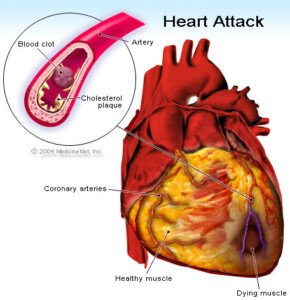
“The longer a plaque has existed and the bigger the plaque, the more stable its surface tends to be,” says Dr. Waissbluth.
“That’s why more major heart attacks happen from plaques occluding 30-50% of the artery than plaques occluding, say, 80% of an artery…the 30-50%’ers are newer and tend to have more active insides and softer outsides – which makes them more likely to rupture.”
Wow! This may explain why the 90-year-old man whose calcium score is a whopping 1,200 (zero indicates zero plaque buildup) has never had a heart attack.
The calcium score procedure measures the amount of hard (calcified and stable) plaque, not the amount of soft (newer and unstable) plaque.
Dr. Waissbluth explains, “When a rupture occurs, your body tries to fix it by creating a plug – just like if you cut your arm you will develop a clot and a scab – this also happens on a ruptured plaque.
“Most of the time the plug seals the tear and then the plaque is fixed and nothing happens.
“BUT if the plug grows and grows it can get very large and shut down the entire artery, and this is how a major heart attack happens.”
Let’s cut in here for a moment. Are you flabbergasted that a 45-year-old person, who hasn’t lived long enough to develop an 80% blockage — and hence is only 30-50% blocked — can actually be at higher risk of a heart attack than is your average 90-year-old?!
And if so, then why aren’t middle-aged and younger adults dropping like flies from heart attacks?
Why are heart attacks much more rampant among people over age 65?
Keep in mind that the age-related risk for heart attack actually begins at 45 for men and 50 for women.
“First and most important, the 90 year old has a lot more 30-50% blockages than the average 45 year old – the older you are the more plaques you get,” says Dr. Waissbluth.
Secondly, by the time a person is old, their heart has been subjected to many factors that could cause or greatly increase the risk of heart attack, whether or not they have excessive soft plaque.
Third, many people under 50 have either a zero calcium score or an indication of only mild heart disease (30-50% is moderate). Keep reading…
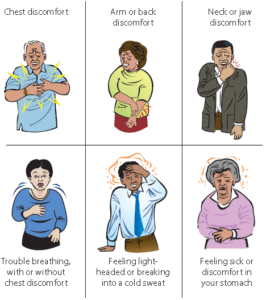
Heart attack symptoms
“The 80% blockage is more likely to cause chest pain while you’re exerting yourself but less likely to rupture,” says Dr. Waissbluth.
It’s less likely to rupture because it’s more likely to be made of hard calcifications.
“The 40%’er will probably never cause pain with activity [because there’s still a relatively wide inner diameter of the artery for blood flow], but is more likely to rupture and cause a big heart attack.”
That’s because the sludge buildup hasn’t been around long enough to calcify much.
Science still can’t pin down the cause of plaque ruptures; only what increases the risk (e.g., smoking, junk food diet, lack of exercise).
In the second type of heart attack there’s no plaque rupture, but there’s reduced blood flow to the heart muscle.
Enough reduced blood flow = heart muscle cells die = heart attack.
“But these aren’t typically as catastrophic or deadly as the major heart attacks from plaque rupture occluding the entire artery,” explains Dr. Waissbluth.
The reduced blood flow results when the supply-demand imbalance becomes too great. The supply of blood cannot keep up with the demand for it.
The inadequate supply may be due to bleeding, anemia, or weak pumping of the heart.
The excessive demand may be caused by a fever/infection, high blood pressure, physical injury elsewhere in the body or physical exertion (like shoveling snow).
These cause the heart to beat faster and harder; in turn the heart muscle cells demand more and the blood supply from the heart arteries simply can’t keep up: So cardiac cells die—a heart attack—without a new blockage.
“These kinds of heart attacks can happen in people with completely normal arteries – no plaques at all, or in people with plaques,” says Dr. Waissbluth.
An elderly person is far more likely to experience this situation “due to having more fixed blockages than a younger person – even if the blockages did not change. The change in demand caused the blockages to become physiologically relevant.”
Put another way, the cumulative effect of fixed (stable) 30-50% blockages interfers with the net amount of passageway through which blood flows.
Think of how water flow would be stunted if many wads of gum were stuck throughout the inner walls of a pipe.
“If you create a supply/demand imbalance and you happen to have a 75% blockage, then you are more likely to have a heart attack than if you had a 40% blockage or no blockage at all.
“But yes these kinds of heart attacks can happen with little or no blockages too.
“The last kind of heart attack is when a virus or your own body’s white cells and immune system attack the heart muscle cells without any change in the arteries or in the supply/demand.”
Now you know why a heart attack can happen without a blockage, and why the risk of heart attack goes up with age, even though younger people are more likely to be 30-50% blocked than severely blocked.

Dr. Waissbluth is affiliated with Atrium Medical Center and has been in practice for 25+ years. Visit Eat Tank.
 Lorra Garrick has been covering medical, fitness and cybersecurity topics for many years, having written thousands of articles for print magazines and websites, including as a ghostwriter. She’s also a former ACE-certified personal trainer.
Lorra Garrick has been covering medical, fitness and cybersecurity topics for many years, having written thousands of articles for print magazines and websites, including as a ghostwriter. She’s also a former ACE-certified personal trainer.
.
Top image: Shutterstock/pickingpok
Can Very Sedentary Person Have Very Low Resting Heart Rate?
So if exercise lowers resting heart rate, why do some sedentary “lazy” people have very slow heart rates?
Yes, this is very possible: A totally out of shape person who gets zero structured exercise could have a low resting pulse, like in the 60s. Does this in and of itself mean they’re fit?
“Genetics impact heart rate,” begins Alvaro Waissbluth, MD, an Ohio-based heart surgeon board certified in interventional cardiology and cardiovascular diseases, and founder of Eat Tank, an educational nutrition initiative that provides simple tools and practical knowledge for better understanding food.
“Twp. people doing and eating exactly the same thing their whole life can have drastically different resting heart rates – just like they will tan to differing degrees based on similar sun exposure and just like their risk of cancer is different,” continues Dr. Waissbluth.
“Also a slow resting heart rate can indicate a deterioration of the conducting system of the heart.”
A slow resting pulse can be indicative of a healthy heart in people who exercise.
But in the person who does not exercise? The slow resting heart rate “can also be indicative of a problem, so it may need to be investigated to make sure nothing worrisome is going on.”
Is there any data out on the mortality risk/life span of sedentary people with slow resting heart rates compared to sedentary people with faster resting pulses, assuming all other variables are matched and adjusted for like smoking, obesity, etc.?
Dr. Waissbluth says, “Yes – but not much. There is some data that suggest a resting heart rate higher than 76 beats per minute is associated with an increased risk of having a heart attack.”
One way to help get the beats per minute under 76 during rest is to practice stress management.
Persistent or free-floating anxiety can keep the ticker going at an undesirably fast rate even when you’re sitting at a computer or watching TV.
Stop smoking and do not entertain the idea that housework substitutes for structured aerobic exercise!
Commit to structured aerobic exercise like walking briskly on a treadmill with an arm pump instead of holding on.

Dr. Waissbluth is affiliated with Atrium Medical Center and has been in practice for 25+ years. Visit Eat Tank.
 Lorra Garrick has been covering medical, fitness and cybersecurity topics for many years, having written thousands of articles for print magazines and websites, including as a ghostwriter. She’s also a former ACE-certified personal trainer.
Lorra Garrick has been covering medical, fitness and cybersecurity topics for many years, having written thousands of articles for print magazines and websites, including as a ghostwriter. She’s also a former ACE-certified personal trainer.
.
Top image: Shutterstock, txking
Why Does My Heart Flutter After Eating?
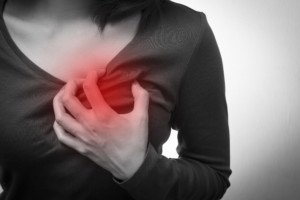
“There are many thoughts as to why one can experience palpitations after a meal,” begins Alvaro Waissbluth, MD, an Ohio-based heart surgeon board certified in interventional cardiology and cardiovascular diseases, and founder of Eat Tank, an educational nutrition initiative that provides simple tools and practical knowledge for better understanding food.
Sometimes the palpitations are described as a “fluttering” heartbeat.
Dr. Waissbluth continues, “One may ingest caffeine or alcohol during the meal and these often cause palpitations.
“Also, one may have a specific food sensitivity which can be mild and manifest in many different ways – such as MSG or shellfish or gluten – and one of the manifestations is frequently palpitations.
“Also, it is possible that the esophagus or stomach could be irritated – people often have esophagitis or gastritis without really knowing it, and eating may irritate their GI tract further – causing angst and discomfort and then palpitations.”
Causes of a fluttering heart after eating continue…
“Also, it is important to note that after you eat, blood flow is automatically redirected away from the muscles and towards the stomach and intestines,” explains Dr. Waissbluth.
“This change can be quite dramatic after a large meal, and the change can lead to people ‘feeling’ their hearts beating differently.”
The fluttering heart after a meal can be mental in origin.
“Occasionally mealtimes can be anxiety provoking for a variety of reasons, and anxiety is a common cause of palpitations.”
When your heart flutters after eating, does this suggest a serious cardiac problem?
Dr. Waissbluth says, “Palpitations are typically not serious, but they can represent a more serious issue – especially if one experiences other symptoms with them – like chest pain, shortness of breath or dizziness.
“It is always recommended to go see your doctor if you have palpitations just to make sure everything is okay.
“The best way to improve palpitations is to try and remove the cause – which takes some figuring out – and oftentimes there is no cause – they ‘just happen.’”
Reducing that fluttering heartbeat may mean elimination of alcohol or caffeine.
And for others it will require avoidance of stress at mealtime. Put away the smartphone and financial reports.
Tell yourself you won’t think about your bills. Just relax and enjoy your meal.
Avoid if possible eating with the so-called toxic people in your life.
“Assuming there is no worrisome underlying heart disease that needs addressed, there are some medicines people can take to try and diminish the sensations/palpitations,” says Dr. Waissbluth.
“But remember, they have side effects, and sometimes the side effects are worse than the palpitations.”

Dr. Waissbluth is affiliated with Atrium Medical Center and has been in practice for 25+ years. Visit Eat Tank.
 Lorra Garrick has been covering medical, fitness and cybersecurity topics for many years, having written thousands of articles for print magazines and websites, including as a ghostwriter. She’s also a former ACE-certified personal trainer.
Lorra Garrick has been covering medical, fitness and cybersecurity topics for many years, having written thousands of articles for print magazines and websites, including as a ghostwriter. She’s also a former ACE-certified personal trainer.
Top image: Shutterstock/Orawan Pattarawimonchai
How Much Olive Oil a Day Is Too Much?
Here’s what a cardiologist/heart surgeon has to say about how much olive oil is too much in a day.
After discovering a super easy way to get more olive oil in my daily diet without cooking it or tasting it, I wondered just how much olive oil in a day is safe—and is there a point where the quantity becomes more adverse?
“There is no reasonable answer to that question, as it has no context…what else is the person eating, etc.,” begins Alvaro Waissbluth, MD, an Ohio-based heart surgeon board certified in interventional cardiology and cardiovascular diseases, and founder of Eat Tank, an educational nutrition initiative that provides simple tools and practical knowledge for better understanding food.
“Navigating the modern food world properly is about understanding what you’re eating. Olive oil contains a lot of fat but it is mostly unsaturated fat.
“The recommendations from various governing bodies are that adults consume approximately 20-30% of their daily calories from fat – of which 2/3 should be unsaturated and 1/3 saturated.
“Fat is a necessary nutrient. If one is eating 2,000 calories a day, then 25% of those from fat would equal 500 calories from fat.
“Fat contains 9 calories/gram so that comes out to about 55 grams of fat allowable per day.
“1/3 of that is about 18.3 grams, so 18.3 grams of saturated fat allowable per day in a 2,000 calorie diet. 2/3 is about 36.6 grams, so 36.6 grams of unsaturated fat per day in the 2,000 calorie diet.
“I personally recommend to my patients that only 20% of their calories come from fat.
“So these numbers would lessen somewhat for my 2,000 calorie a day patient.”
Olive Oil in a Day: How Much?
Dr. Waissbluth continues, “Back to olive oil – 1 tablespoon contains about 14 grams of fat ~ 2 saturated and 12 unsaturated.
“If you ate 9 tablespoons you’d get your 18 grams of saturated fat in for the day but way overshoot your unsaturated.
“And if you ate 9 tablespoons you ought not have any other sources of saturated fat in your day.
“If you eat 1 tablespoon you get 2 and 12 respectively and would be lacking in your fat intake for the day – need to make it up elsewhere.
“However, remember, these numbers are not hard and fast rules. They are guidelines.
“If you eat 30 grams of saturated fat one day, that is not the end of the world – you simply curtail your sat fat intake somewhat for the next few days.
“Drinking olive oil is unreasonable – what IS reasonable is to include extra virgin olive oil as part of a diverse predominantly plant based diet and to understand macronutrients way better than the average person currently does.
“It is simply necessary to be able to exist at one’s healthiest, given the food environment/era we were born into.”
The closer food is to nature, the better it is for you. That’s the general rule.
An apple is better than apple sauce is better than apple juice is better than apple pie.
As for easily getting uncooked olive oil into your diet without tasting it, put one tablespoon into your protein drink or fruit smoothie. You will NOT taste it!
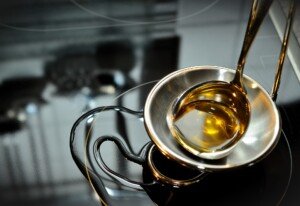

Dr. Waissbluth is affiliated with Atrium Medical Center and has been in practice for 25+ years. Visit Eat Tank.
 Lorra Garrick has been covering medical, fitness and cybersecurity topics for many years, having written thousands of articles for print magazines and websites, including as a ghostwriter. She’s also a former ACE-certified personal trainer.
Lorra Garrick has been covering medical, fitness and cybersecurity topics for many years, having written thousands of articles for print magazines and websites, including as a ghostwriter. She’s also a former ACE-certified personal trainer.
Is a Resting Pulse of 100-105 Bad?

If your resting heart rate is 100 to 105, you’d better read this article to find out what the bad news is.
The straight question is:
Can a resting heart rate of 100 to 105 beats per minute be harmful to the heart or in some way be tied to a future health ailment?
“Yes – there is emerging evidence that higher resting heart rates correlate with increased cardiovascular risk,” says Alvaro Waissbluth, MD, an Ohio-based heart surgeon board certified in interventional cardiology and cardiovascular diseases, and founder of Eat Tank, an educational nutrition initiative that provides simple tools and practical knowledge for better understanding food.
Dr. Waissbluth continues, “There are many risk factors that influence one’s risk of cardiovascular disease and they all have a cumulative effect.”
If your resting pulse tends to be between 100 and 105, there are things you can do to lower it, but you’ll probably need some patience; don’t expect the lowering to occur overnight.
First off, stop smoking if you smoke. Smoking accelerates resting pulse. This speeding up does NOT strengthen the heart.

Shutterstock/Bogdan Vija
However, the elevated heart rate that comes from structured exercise does improve the heart.
Aerobic exercise three times a week, and strength training on other days, will lower a fast resting pulse.
Tip: If you use a treadmill, do NOT hold on. Pump your arms.
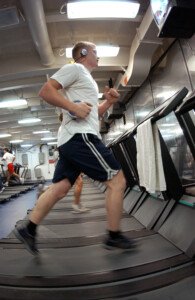
Consistency in your exercise is crucial: three times a week, week after week, month after month — for the rest of your life.
Two of these three cardio workouts should be of the interval training type: alternating brief high exertion with casual recovery periods.
Interval training should be high intensity or medium/high intensity for best results.
Strength training should include many intense routines that get your heart rate up like heavy kettlebell swings, deadlifts and squats, but the interval cardio training will have the much greater impact on lowering a fast resting heart rate.
Another way to knock down that resting pulse of 100 to 105 is to eliminate excessive sitting throughout the day.
On TV commercial breaks, walk around. Always walk about when on the phone.
A resting pulse in the low 100s is nothing to sneeze at.

Dr. Waissbluth is affiliated with Atrium Medical Center and has been in practice for 25+ years. Visit Eat Tank.
 Lorra Garrick has been covering medical, fitness and cybersecurity topics for many years, having written thousands of articles for print magazines and websites, including as a ghostwriter. She’s also a former ACE-certified personal trainer.
Lorra Garrick has been covering medical, fitness and cybersecurity topics for many years, having written thousands of articles for print magazines and websites, including as a ghostwriter. She’s also a former ACE-certified personal trainer.
.
Top image: ©Lorra Garrick
How to Overcome Obsessing About Your Blood Pressure Readings
Does Normal Blood Pressure Mean You Don’t Have Heart Disease?
Palpitations During Bowel Movements: Causes, Solutions
Yes, palpitations CAN occur as a result of a bowel movement, and a cardiologist explains why pooping can make you feel as though your heart skipped a beat.
“Anything that causes pain or anxiety can cause palpitations,” begins Alvaro Waissbluth, MD, an Ohio-based heart surgeon board certified in interventional cardiology and cardiovascular diseases, and founder of Eat Tank, an educational nutrition initiative that provides simple tools and practical knowledge for better understanding food.
“And if there is a big hard painful poop, this can in turn cause palpitations.”
The pooping itself usually does not cause the palpitations in a direct fashion.
But when having a bowel movement, some people develop anxiety — for a number of reasons.
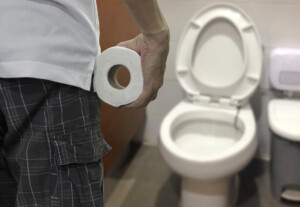
Shutterstock/laymanzoom
One of them might be fear of developing a hemorrhoid. Or, it could be fear of colon cancer.
They are driven to inspect their poops with every movement, afraid that the next inspection is going to reveal blood or some other concerning feature.
Another source of anxiety could be that of having a big bowel movement in a public restroom — while someone is in the stall right next to you.
Or maybe you’re in a restaurant bathroom and you’re worried that someone in your party — wondering what’s taking you so long — is going to walk into the john any moment calling out your name. Let the palpitations begin!
Dr. Waissbluth adds, “There are also transient shifts in blood flow during bowel movements which, for people very sensitive to their heartbeats, can lead to ‘feeling’ more heartbeats.
“Also, bearing down too much can alter the return of blood to the heart and cause various changes in heart rate as well, and this too can lead to palpitations.”
Bearing down refers to holding your breath as you push to get a tough poop out.
Try not to hold your breath. Instead, concentrate on exhaling during the push. Holding your breath during such an action will raise blood pressure.
Is there a way to prevent or reduce palpitations during a bowel movement?
Dr. Waissbluth says, “Eat more fiber, bear down less, enjoy the poop by golly.”
One medium apple = five grams of fiber. One medium banana = three grams.
One tablespoon of chia seeds, which you can sprinkle in salads and rice, contains three grams.
Do Not Worry About Palpitations During Pooping
“There is typically nothing to worry about, as most palpitations are benign,” says Dr. Waissbluth.
“But you never know if there is an underlying heart issue, so always check with your doctor, as some simple noninvasive testing can get to the answer quickly and easily.”

Dr. Waissbluth is affiliated with Atrium Medical Center and has been in practice for 25+ years. Visit Eat Tank.
 Lorra Garrick has been covering medical, fitness and cybersecurity topics for many years, having written thousands of articles for print magazines and websites, including as a ghostwriter. She’s also a former ACE-certified personal trainer.
Lorra Garrick has been covering medical, fitness and cybersecurity topics for many years, having written thousands of articles for print magazines and websites, including as a ghostwriter. She’s also a former ACE-certified personal trainer.
.
Top image: Freepik.com, jcomp
Pulled Chest Muscle vs. Heart Problem
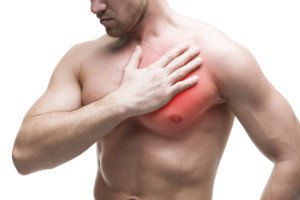
A cardiologist addresses whether a pulled chest muscle has different features than a heart problem or angina and vice versa.
A pulled or strained chest muscle is no picnic to have. It can hurt.
And sometimes, the discomfort doesn’t kick in till the day after a chest workout—making it, in a way, seem less likely connected to your bench pressing, pushups or whatever.
(Though any fitness aficionado would be very familiar with delayed onset muscle soreness.)
Differences Between Strained Chest Muscle and Cardiac Pain, Angina
“Musculoskeletal chest pain tends to be quite different from worrisome heart pain,” says Alvaro Waissbluth, MD, an Ohio-based heart surgeon board certified in interventional cardiology and cardiovascular diseases, and founder of Eat Tank, an educational nutrition initiative that provides simple tools and practical knowledge for better understanding food.
Dr. Waissbluth continues, “Musculoskeletal chest pains almost always change with physical movement of the chest wall either from breathing or moving one’s arms or body.
“This causes tension on the actual muscles or tendons or ligaments or joints that are inflamed and makes them hurt.”
This is a hallmark feature of chest muscle soreness.
Like any sore or strained muscle, the pain will fluctuate or be aggravated with movement.
“Also, musculoskeletal chest pains are often fleeting – lasting a few seconds at most –and go away when the movement is over.”
Angina doesn’t last for three seconds.
Pay attention to your movements.
What motions did you carry out just before that fleeting “chest pain”?
The offending motion could have even been committed while you were seated—simply twisting in your chair, pressing a hand against the armrest, may be all it takes to buzz the strained chest muscle.
“They are rarely accompanied by other symptoms and typically don’t radiate anywhere else,” says Dr. Waissbluth, referring to musculoskeletal pain.
If you seemingly have persistent chest pain that you suspect is from a gym workout, pay very close attention to your breathing.
You may find that the pain surfaces only at the bottom of an exhalation or at the top of an inhalation, but it seems as though the chest pain is persistent or constant because you’re taking breaths every several seconds.
Take an exaggerated exhalation or inhalation to see if either bring out the discomfort.
Hold your breath to see if the discomfort vanishes!
Holding your breath won’t make angina or other heart pain vanish!
“Chest pain from heart problems, on the other hand, almost never changes with breathing or moving around, is usually in the middle of the chest or left sided, often radiates to the left arm and/or neck and/or jaw and/or shoulder and/or back, is often associated with shortness of breath, nausea and/or sweating, and lasts typically minutes or longer,” explains Dr. Waissbluth.
This isn’t to say, however, that angina can’t ever present as just chest pain only or right-side dominant.
But remember, angina or cardiac pain won’t fluctuate, improve or worsen with changes in breathing and body position.
Dr. Waissbluth continues, “Whereas musculoskeletal pains change with sitting in place and moving one’s torso or arms or taking a deep breath, it is actual physical exertion such as climbing stairs or walking up a hill or carrying something that can precipitate chest pain from a heart problem.”
Gee, how could that sudden “chest pain” while you’re sitting at your computer (when your oxygen demands are thus very low) be from a heart problem when just yesterday you did 50-pound kettlebell swings and 6 RM bench presses (huge oxygen demands) without incident?

Shutterstock/Jasminko Ibrakovic
“But you don’t need to move at all [trot up stairs, shovel snow, lift heavy box, run on treadmill] to have chest pain from a heart problem – as if a plaque ruptures and causes a heart attack while you’re sleeping or watching TV, you can have typical heart chest pain just lying or sitting there.”
Of course, chest pain from a plaque rupture won’t be fleeting.
People who’ve suffered plaque ruptures will tell you that the pain didn’t get better or subside; it persisted, perhaps became worse, and was (most very likely) accompanied by other frightening symptoms such as shortness of breath and profuse sweating.
Dr. Waissbluth adds, “However there is no absolute rule! These are guidelines. Any chest pain of any quality should be reported to your doctor to figure out.”
To non-invasively find out if you have an abnormal amount of soft plaque in your coronary arteries (the type that can rupture), you’d have to undergo a magnetic resonance angiogram — and this procedure is not given to asymptomatic people as a screening tool for heart disease.
You can kick back soft plaque buildup by cutting back (and a LOT, not a little) on processed foods!
As for chest muscle pain, make a habit of warming up generously prior to chest routines, and keep in mind that back routines can aggravate chest muscles.

Dr. Waissbluth is affiliated with Atrium Medical Center and has been in practice for 25+ years. Visit Eat Tank.
 Lorra Garrick has been covering medical, fitness and cybersecurity topics for many years, having written thousands of articles for print magazines and websites, including as a ghostwriter. She’s also a former ACE-certified personal trainer.
Lorra Garrick has been covering medical, fitness and cybersecurity topics for many years, having written thousands of articles for print magazines and websites, including as a ghostwriter. She’s also a former ACE-certified personal trainer.
Top image: Shutterstock/staras
Stabbing Chest Pain when Lying on Left Side: Heart or Muscle?
Chest Pain with Hoarse Voice: May Be Cancer or Aortic Aneurysm
Coconut Saturated Fats vs. Meat Sat Fats
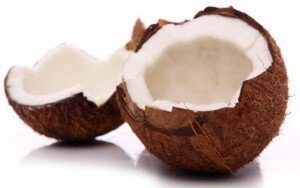
A heart specialist addresses whether coconut oil’s saturated fats are as bad as those from meat.
There’s a lot of online content touting the health virtues of coconut oil, even though it’s loaded with saturated fats.
Proponents of coconut oil and shreds say that the sat fats are of a different (and healthier) molecular structure than those that come from beef and other types of meat.
“Coconut oil is not as good as current marketers try to make it out to be and not as awful as once thought,” begins Alvaro Waissbluth, MD, an Ohio-based heart surgeon board certified in interventional cardiology and cardiovascular diseases, and founder of Eat Tank, an educational nutrition initiative that provides simple tools and practical knowledge for better understanding food.
Dr. Waissbluth continues, “The ‘bad’ coconut oil from days gone by was typically refined – bleached and partially hydrogenated – and this type has multiple unpleasant health effects – as do most manmade processed foods.”
This means that jar of “refined” coconut oil sitting on your shelf is bad news!
In addition to the trans fats of the partial hydrogenation process, the refined version often has sodium hydroxide added to extend shelf life. The refining process may also involve chemical solvents.
“The modern ‘good’ coconut oil is virgin coconut oil – untouched by man [unrefined] – and even though it is predominantly saturated fat – over 90% – most of these are medium chain triglycerides which are processed differently [once inside the body] than the long chain ones (which are found in most other vegetable oils and almost all animal products),” explains Dr. Waissbluth.
Buy the unrefined version, even if the solidified oil looks clumpy inside the jar.
“These medium chain TGs have been postulated to have some beneficial effects and have shown very modest benefit in small trials and animal studies,” says Dr. Waissbluth.
“However, there is no definitive data which leads any health professional who is not being paid by a coconut oil seller/reseller to recommend virgin coconut oil be used any more than sparingly in any given diet.
“There is NO good long-term data on humans that show cardiovascular benefit. Period.”
This is bad news for those of you who are hooked on raw chocolate coconut balls sweetened with dates and/or Stevia — seemingly a great replacement for the standard candy bar and especially a more processed item like brownies and cake.
If you’re feeling your way around the saturated fats of coconut oil vs. meats and just don’t know what to do, one thing that will help make things a little clearer is to get your cholesterol profile regularly checked.
Changes in diet can rapidly alter your lipid profile.

Dr. Waissbluth is affiliated with Atrium Medical Center and has been in practice for 25+ years. Visit Eat Tank.
 Lorra Garrick has been covering medical, fitness and cybersecurity topics for many years, having written thousands of articles for print magazines and websites, including as a ghostwriter. She’s also a former ACE-certified personal trainer.
Lorra Garrick has been covering medical, fitness and cybersecurity topics for many years, having written thousands of articles for print magazines and websites, including as a ghostwriter. She’s also a former ACE-certified personal trainer.
.
Top image: Freepik.com, Racool_studio
How Does Stress Cause a “Skipped” Heartbeat?
A heart surgeon explains how stress can cause a “skipped” heartbeat.
Keep in mind that what may feel like your heart skipping a beat isn’t necessarily actually that at all, but rather, the next beat occurs so close to the previous one, that this leaves a gap before the next beat after that, creating the illusion that your heart literally skipped a beat.
“Stress causes increased heart rate and blood pressure by increasing the release of adrenalin and adrenalin-like substances in the body,” says Alvaro Waissbluth, MD, an Ohio-based heart surgeon board certified in interventional cardiology and cardiovascular diseases, and founder of Eat Tank, an educational nutrition initiative that provides simple tools and practical knowledge for better understanding food.
Dr. Waissbluth continues, “Adrenalin increases heart rate and blood pressure which can lead to abnormal or fast heart rhythms along with the sensation of skipped beats and palpitations.”
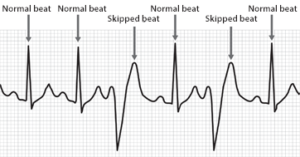
Adrenalin and like-hormones are the so-called “fight or flee” hormones. They prepare your body for an encounter with danger.
The body, however, doesn’t know the difference between the dangers that primitive man had to face (an encounter with a wild boar) and the “dangers” that industrialized people must face (opening the letter that has your mammogram results).
The chemical fear response in the body is the same in either case. To put it in layman’s terms, these hormones can trip things up, leading to a momentary erratic heart rhythm, what is often called a palpitation, or a thumping or fluttering heartbeat.
There’s a lot of truth to that age-old saying, “My heart skipped a beat when I found out I owed so much in taxes!”

Dr. Waissbluth is affiliated with Atrium Medical Center and has been in practice for 25+ years. Visit Eat Tank.
 Lorra Garrick has been covering medical, fitness and cybersecurity topics for many years, having written thousands of articles for print magazines and websites, including as a ghostwriter. She’s also a former ACE-certified personal trainer.
Lorra Garrick has been covering medical, fitness and cybersecurity topics for many years, having written thousands of articles for print magazines and websites, including as a ghostwriter. She’s also a former ACE-certified personal trainer.


